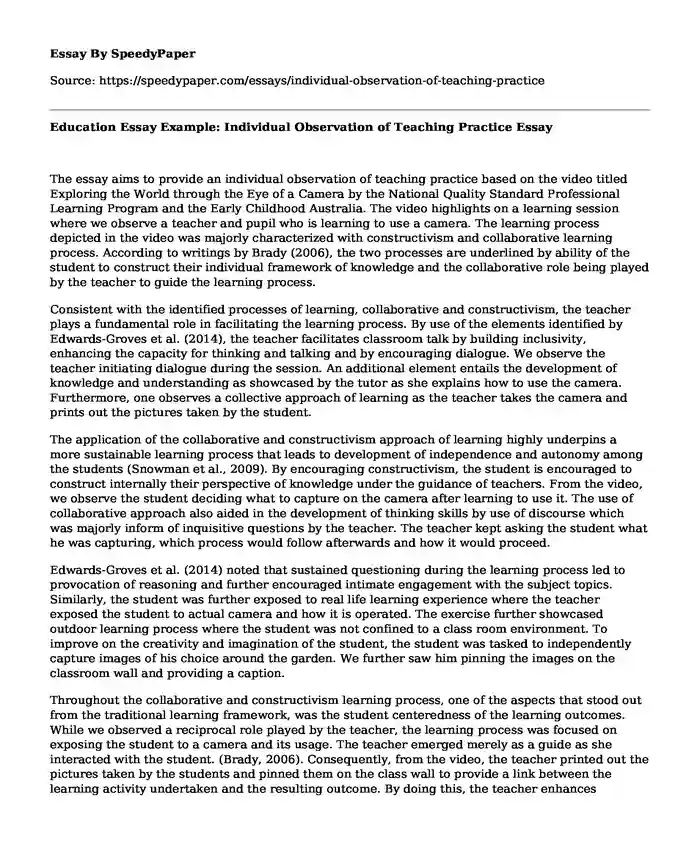The essay aims to provide an individual observation of teaching practice based on the video titled Exploring the World through the Eye of a Camera by the National Quality Standard Professional Learning Program and the Early Childhood Australia. The video highlights on a learning session where we observe a teacher and pupil who is learning to use a camera. The learning process depicted in the video was majorly characterized with constructivism and collaborative learning process. According to writings by Brady (2006), the two processes are underlined by ability of the student to construct their individual framework of knowledge and the collaborative role being played by the teacher to guide the learning process.
Consistent with the identified processes of learning, collaborative and constructivism, the teacher plays a fundamental role in facilitating the learning process. By use of the elements identified by Edwards-Groves et al. (2014), the teacher facilitates classroom talk by building inclusivity, enhancing the capacity for thinking and talking and by encouraging dialogue. We observe the teacher initiating dialogue during the session. An additional element entails the development of knowledge and understanding as showcased by the tutor as she explains how to use the camera. Furthermore, one observes a collective approach of learning as the teacher takes the camera and prints out the pictures taken by the student.
The application of the collaborative and constructivism approach of learning highly underpins a more sustainable learning process that leads to development of independence and autonomy among the students (Snowman et al., 2009). By encouraging constructivism, the student is encouraged to construct internally their perspective of knowledge under the guidance of teachers. From the video, we observe the student deciding what to capture on the camera after learning to use it. The use of collaborative approach also aided in the development of thinking skills by use of discourse which was majorly inform of inquisitive questions by the teacher. The teacher kept asking the student what he was capturing, which process would follow afterwards and how it would proceed.
Edwards-Groves et al. (2014) noted that sustained questioning during the learning process led to provocation of reasoning and further encouraged intimate engagement with the subject topics. Similarly, the student was further exposed to real life learning experience where the teacher exposed the student to actual camera and how it is operated. The exercise further showcased outdoor learning process where the student was not confined to a class room environment. To improve on the creativity and imagination of the student, the student was tasked to independently capture images of his choice around the garden. We further saw him pinning the images on the classroom wall and providing a caption.
Throughout the collaborative and constructivism learning process, one of the aspects that stood out from the traditional learning framework, was the student centeredness of the learning outcomes. While we observed a reciprocal role played by the teacher, the learning process was focused on exposing the student to a camera and its usage. The teacher emerged merely as a guide as she interacted with the student. (Brady, 2006). Consequently, from the video, the teacher printed out the pictures taken by the students and pinned them on the class wall to provide a link between the learning activity undertaken and the resulting outcome. By doing this, the teacher enhances comprehension of the students while at the same time stimulating their learning capabilities. Vis a vis, it suffices to note that collaborative and constructivism approaches to learning not only facilitates classroom discourse but also leads to improved learning by fostering teacher student relationships.
References
Snowman, J. Dobozy, E. Scevak, J. Bryer, F. Bartlett, B. & Biehler, R. (2009). Psychology applied to teaching ( 1st Australian ed). Milton, Qld: John Wiley & Sons.
Brady, L. (2006). Collaborative Learning in Action. Sidney: Pearson Prentice Hall.
Edwards-Groves, C., Anstey, M., & Bull, G. (2014). CLASSROOM TALK: Understanding dialogue, pedagogy and practice. Newtown: Primary English Teaching Association Australia (PETAA).
Cite this page
Education Essay Example: Individual Observation of Teaching Practice. (2020, Jun 10). Retrieved from https://speedypaper.net/essays/individual-observation-of-teaching-practice
Request Removal
If you are the original author of this essay and no longer wish to have it published on the SpeedyPaper website, please click below to request its removal:
- Essay Example on the Flat Organizational Structure of Dabbawala
- Essay Sample on Cancer Risk
- Essay Sample Analyzing Babylon Revisited by F. Scott Fitzgerald
- Essay Sample on Poverty in the World
- Essay Example: The Flow of Funds in Baylor Hospital
- Essay Example on Judging People by Their Social Media Posting
- Research Paper on Water in New Mexico
Popular categories





